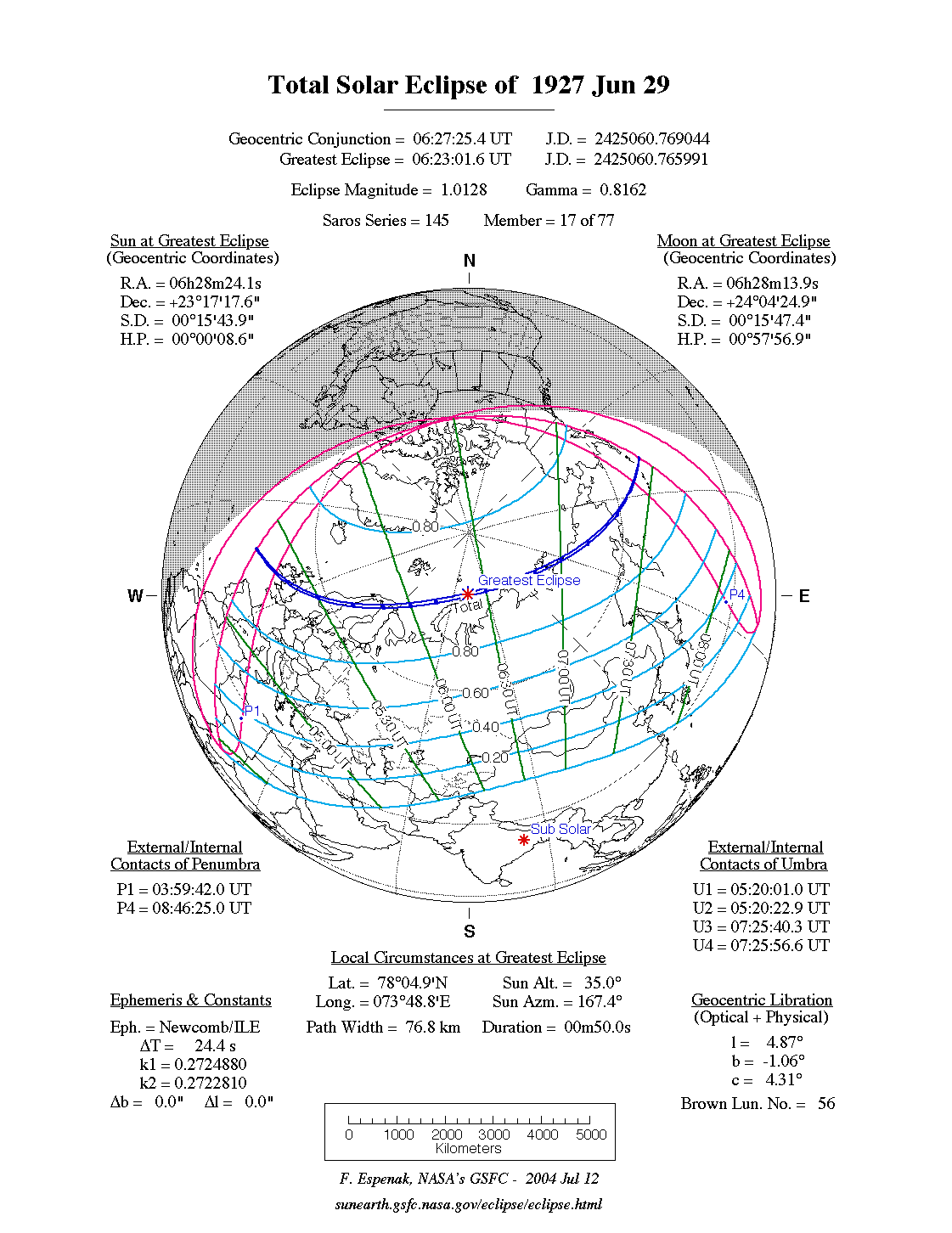A total eclipse of the Sun occurred on Wednesday 29 June, 1927 UT, lasting from 03:59–08:46 UT. The Sun was darkened for 50 seconds by a dramatic total eclipse covering a narrow path at most 77 km wide. This was a sight worth seeing, and was visible across the centre of Great Britain, Norway and Sweden, the Arctic, and eastern Russia. The partial eclipse was visible from Europe and northern Asia.
The timings of the phases of the overall eclipse
worldwide are as follows. In any particular
place it would have been seen for a significantly shorter
duration as the shadow moved across the Earth:
| Partial eclipse began: |
03:59:42 UT |
| Total eclipse began: |
05:20:01 UT |
| Maximum eclipse: |
06:23:02 UT |
| Total eclipse ended: |
07:25:57 UT |
| Partial eclipse ended: |
08:46:25 UT |
During this eclipse the Sun was 0.524° in apparent
diameter, 1.6% smaller than average. The Moon was 5 days after perigee and 7 days before apogee.
At the start and end of the eclipse the Moon
was 0.526°, and at maximum eclipse 0.531°,
which is around average; hence it covered the Sun,
making this a total eclipse.
The statistics page has information on the ranges of the sizes of
the Sun and Moon, and the Moon data page displays detailed
information on the Moon's key dates.
The next eclipse in the triple-Saros series occured on Jul 31, 1981, but too far to the east to be seen in Britain. But the very next eclipse after that in this Saros series happened on Aug 11 1999!
The very beginning of this eclipse was visible just after dawn in the UK. The total eclipse narrowly missed Ireland, and reached north-west Wales at 05:23 UT. The path was 44 km (27.3 miles) wide here, and the total eclipse lasted 20 seconds on the centreline. The track then whipped quickly over Southport and Middlesbrough, reaching the North Sea at 05:25 UT.
Interactive Map
This map shows the visibility of the eclipse.
The shaded area saw the total solar eclipse; however, near the edges of
this area, the eclipse was very short. The bold line shows the centre
of the path, where the eclipse lasted longest.
Use the zoom controls to zoom in and out; hover your mouse over any
point on the centreline to see the time and
duration of the eclipse at that point. You can pan and zoom the map to
see detail for any part of the eclipse path.
The interactive map is currently not available.
Overview Map
This map sourced from NASA Goddard Space flight Center: GSFC Eclipse Web SiteGSFC Eclipse Web Site
The primary source of all the information on eclipses presented here at Hermit Eclipse. (NASA Goddard Space flight Center)
shows the visibility of the total solar eclipse. It also shows the broader area in which a partial eclipse was seen. (Click on it for the
full-sized version.)
Eclipse Season and Saros Series
This eclipse season contains 2 eclipses:
This was the 17th eclipse in solar Saros series 145.The surrounding eclipses in this Saros series are:
This Saros series, solar Saros series 145,
is linked to lunar Saros series 138. The
nearest partner eclipses in that series are:
Eclipse Parameters
| UT Date/time (max) | 06:23:03 on 29 Jun UT |
TDT Date/time (max) | 06:23:27 on 29 Jun TDT |
| Saros Series | 145 |
Number in Series | 17 |
| Penumbral Magnitiude | |
Central Magnitiude | 1.0128 |
| Gamma | 0.8163 |
Path Width (km) | 77 |
| Delta T | 0m24s |
Error | ± 0m00s (95%) |
| Penumbral Duration | |
Partial Duration | |
| Total Duration | 0m50s |
| |
| Partial Rating | |
Total Rating | |
| Sun Distance | 152095857 km (103.4%) |
Moon Distance | 378403 km (43.7%) |
| Sun Diameter | 0.524° |
Moon Diameter | 0.526° - 0.531° |
| Perigee | 09:56 on 24 Jun UT |
Apogee | 23:53 on 6 Jul UT |
| Contact p1 | 03:59:42 on 29 Jun UT |
Contact p2 | |
| Contact u1 | 05:20:01 on 29 Jun UT |
Contact u2 | 05:20:23 on 29 Jun UT |
| Max eclipse | 06:23:02 on 29 Jun UT |
| Contact u3 | 07:25:40 on 29 Jun UT |
Contact u4 | 07:25:57 on 29 Jun UT |
| Contact p3 | |
Contact p4 | 08:46:25 on 29 Jun UT |
Note that while all dates and times on this site (except
where noted) are in UT, which is within a second of civil time,
the dates and times shown in NASA's eclipse listingsGSFC Eclipse Web Site
The primary source of all the information on eclipses presented here at Hermit Eclipse. (NASA Goddard Space flight Center)
are in the TDT timescale.
The Sun and Moon distances are shown in km, and as a
percentage of their minimum - maximum distances; hence 0%
is the closest possible (Earth's perihelion, or the
Moon's closest possible perigee) and 100% is
the farthest (aphelion, the farthest apogee).
The statistics page has information on the ranges of sizes
of the Sun and Moon, and the Moon data page displays detailed
information on the Moon's key dates.
Data last updated: 2015-06-21 22:11:46 UTC.

